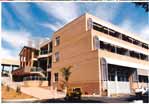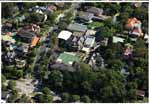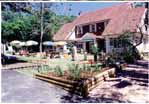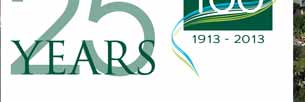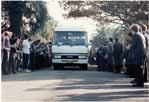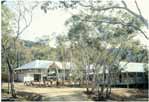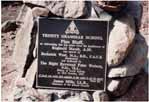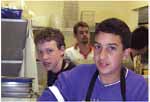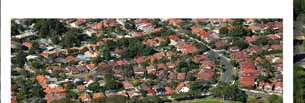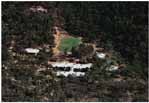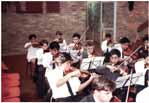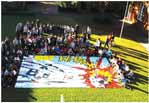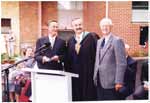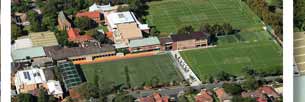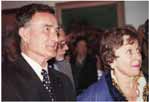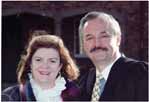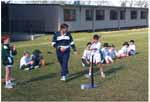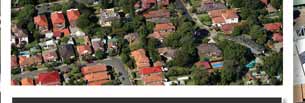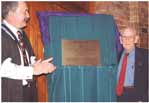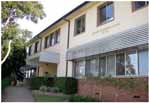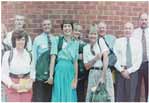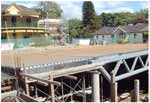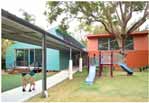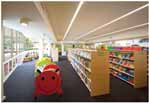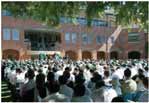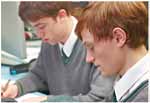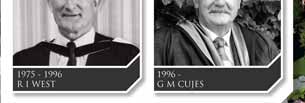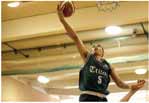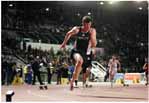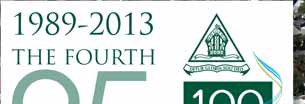
FOURTH 25 YEARS 1989-2013
The fourth quadrant of Trinity’s Century has been one of expansion – numerically, physically and in educational opportunity. It has also seen some outstanding achievements both academically and on the sports field.
During Mr West’s Headmastership 1975-1996, pupil numbers at the Preparatory School rose from 440 to 587 and in the Secondary School from 685 to 1105. The House system was once again expanded, with four additional Houses (Murphy, Stephenson, Weeks and Wynn Jones) taking the total to sixteen. The campuses were also changing. At Summer Hill an additional wing was added to the old Arts and Crafts building to form the Design Centre, and a large Gymnasium was opened in 1989. In the narrow area between these two buildings, the School of Science was built (1996). At Strathfield, Milverton was extended for the infant pupils in 1991, and an adjoining property – Somerset – was purchased in same year.
As Trinity celebrated its 80th Anniversary in 1993, the School had two visitors whose living memory connected them with the era of Trinity’s infancy. The first was an Old Trinitarian, Mr Max Whyte, the last surviving pupil from Trinity’s foundation year, 1913, who attended the School’s 80th Anniversary Service at St Andrew’s Cathedral. The second was Mr Jack Hazlitt, a Gallipoli veteran born in 1897, who visited the School during Term 2. The Head Master commented “Our boys will be able to tell their grandsons sixty years hence, that they once laid eyes upon a Gallipoli veteran and so there will be a continuing line of history from 1915 to 2060”.
PINE BLUFF
1993 was also the year Trinity’s outdoor education centre, Pine Bluff, was opened and dedicated. This 700 hectare bush property located on the Abercrombie River near Bigga in the Southern Tablelands of NSW, was donated by Old Trinitarian Mr Reg Marsh (Class of 1924). Initially, small groups of Year 9 boys undertook a five week residential programme during which they experienced a variety of learning activities. The Head Master, Mr West, described it as “a new direction, a more contemplative type of education, an opportunity for a boy to work through his values in life and come to terms with his own being in the eerie stillness of remote Australia on this grand site set amidst eucalyptus trees and overlooking a wide arm of the Abercrombie”.
In 2013, Year 9 pupils are still enjoying a four-week Outdoor Education Residential Programme and Year 6 boys from the Preparatory and Junior Schools also attend week-long camps at Pine Bluff.
THE ARTS
The musical experience of Trinity boys reached new heights during this quarter century. 1994 saw the transformation of the String and Wind Orchestras into the School’s first Symphony Orchestra. This was the culmination of years of planning beginning with provision of violins to Year 2 Prep boys in the early 1980s. By 1992, half the boys in Year 7 were learning an instrument, and Trinity musicians were participating in eisteddfods and tours as well as regularly performing. That same year the Cadet Band turned 40 and was placed first in the Sydney Anzac Day march. In 1996 construction began on a new music facility at Summer Hill. Named in honour of the retiring Head Master, the Roderick West School of Music was opened on 17 October 1996 by Miss Lauris Elms AM, OBE, a renowned singer with a long association with Trinity’s Society of the Arts. The annual Festival of the Arts was inaugurated in 1997 as a School-wide celebration of the creative, dramatic, musical and artistic character of the boys.
A NEW HEAD MASTER, CURRICULA AND TECHNOLOGY
In mid-1996 a new Head Master, Mr G Milton Cujes, took up his post. As an Old Trinitarian, the 1968 School Captain, and a former staff member (1972-79), Mr Cujes returned to a School considerably augmented since he had last left it.
With enrolments in the Secondary School alone exceeding 1000, the concept of the ‘Middle School’ (Years 7 to 9) was introduced to meet the educational needs and challenges of boys in this age group. The Middle School has its own House Masters, assemblies and Speech Days, in parallel with the Senior School (Years 10 to 12).
Trinity was also catering for pupils with special needs as well as those who were gifted and talented. Existing programmes were reorganised into the Trinity Education Support Services (TESS) in 1997, and in 2002 an Extension Class, providing enhanced curriculum opportunities in English, Mathematics, Science, History and foreign language study, was introduced for Year 8 boys identified as high achieving all-rounders.
With high retention rates in senior years and a Year 12 cohort approaching 200, Trinity embraced the opportunity to prepare boys for the International Baccalaureate (IB) Diploma as well as the NSW Higher School Certificate (HSC). The 21 foundation IB students took their first examinations in November 2000, and by 2012 Trinity had 394 IB graduates. In recognition of student diversity, additional HSC courses were also introduced and the Trinity Enterprise Education Programme (TEEP) was also developed for senior boys aiming for vocational training rather than university entrance. Its first ten pupils graduated in 2011.
Trinity was therefore well placed to cope with the raising of the NSW legal school leaving age from 15 to 17 years in 2010 and the abolition of State-wide Year 10 examinations, the School Certificate being replaced by a Record of School Achievement (RoSA).
Academic excellence, long valued at Trinity, flourished towards the end of its century. Since 1988, over 280 boys have been counted in the top 1% of the State and an annual Scholars’ Assembly was begun in 1996 as a way of recognising these outstanding achievers.
In the broader educational arena, annual National Literacy and Numeracy Tests (NAPLAN) for Years 3, 5, 7 and 9 were established between 2002 and 2008, and preparations gained momentum for the introduction of the first stage of the Australian Curriculum in 2014.
As a new century approached, blackboards gave way to whiteboards and interactive white boards. In 2008 the Federal government initiated its Digital Education Revolution reform policy to support Information and Communication Technology learning. A generation of technology savvy pupils emerged, and in 2011 the School began to issue iPads to secondary pupils. Textbooks, homework, learning resources, messages, and ‘virtual classrooms’ are all accessed by students through this means. Even that old school tradition of marking the roll became electronic! However, personal growth and character development remain important and to enhance these aspects a Service Week was introduced in 2012.
GROWTH AND CHANGE
While Sydney was preparing to host the Olympic Games in 2000, Trinity was preparing another means of expansion. After an attempt to obtain an additional campus in the southern suburbs, the enterprise being frustrated by unforeseen conditions, the Junior School started at the Summer Hill campus in February 2000, with 5 teachers and 70 boys (Years 3 to 6) occupying temporary buildings located on the basketball courts. As boarder numbers were reduced from an average of 72 in 1988 to approximately 40, the Boarding House was relocated in 2003 to Bishop Chambers House (formerly Chesalon Aged Care facility) on Prospect Road, and the old dormitories became the home of the growing Junior School. In 2006 premises were leased at Lewisham where Pre-K to Year 2 classes were added. In 2012, a magnificent purpose-built Junior School on Seaview Street was occupied by more than 300 Junior School boys.
Nor had the Preparatory School stood still during this time. Additional classrooms were constructed in 2003, a Gymnasium and Music Centre in 2005, and a Multipurpose Pavilion and new Library in 2011.
Another innovation for has been the accreditation of Trinity in 2010 to teach the International Baccalaureate Organisation’s Primary Years Programme (PYP) in the Preparatory and Junior Schools - a curriculum framework based on Units of Enquiry.
The Summer Hill campus has also seen further expansion. Additional Maths classrooms were lifted onto the roof of the Gymnasium, and the original Founder’s Building – the first new building added by Trinity in 1937 – was demolished to make way for a new Founder’s equipped for the new millennium. Another large scale project was the redevelopment of No 2 Oval with an underground car park, fitness centre and synthetic surface playing field, opened in 2010.
CAS SUCCESSES
In 2009 the Combined Associated Schools (CAS) celebrated the 80th anniversary of its formation. Its initial competitions in Athletics, Cricket, and Rugby have since been expanded to 14 areas of competition including Chess and Debating.
Since 1988, Trinity has achieved some remarkable sporting successes in the CAS arena. In Summer Volleyball, Trinity has been the victor for eight years in a row and has won in 22 of the last 25 years; and in Winter Volleyball has a seven year winning streak and 15 premierships in the last 25 years. After a 38 year drought Trinity won the Swimming competition in 2004, and has since gained The Thyne Challenge Shield ten times in succession. Trinity’s divers have also been extraordinarily successful winning The Steven Barnett shield on 21 of the last 25 occasions. Another drought was broken in 2009, when 54 years after their last success, Trinity won the Andrew Reid Challenge Cup for Athletics. In Basketball, Trinity has been the premier for five successive years since 2009, and the Chess players have also brought home the C J S Purdy Cup on four occasions since it was first awarded in 2001. In the last quarter century Trinity has revealed a breadth of talent by winning every CAS competition at least once.
THE CENTENARY
In 2013, a thriving Trinity paused to reflect and to celebrate its centenary. Events were held throughout the year to gather different parts of the Trinity family to commemorate the School’s foundation, life and continuing spirit over a century of change and challenge.
The Founder’s vision continues – that through God’s grace Trinity may continue to send forth into the world young men who have grown in mind, body and spirit, in stature and in favour with God and man.
Detur Gloria Soli Deo.
FOURTH 25 YEARS | 1989-2013
1913 – 57 pupils and 5 staff
1939 – 196 pupils and 12 staff
1962 – 995 and 54 (teaching) staff
1988 – 1,507 pupils and 115 (teaching) staff
2013 – 2,045 pupils and 364 (permanent teaching and support) staff
5,500+ pupils passed through the classrooms of Trinity between 1989 and 2013.
90 Old Trinitarians have returned as staff members, and of these 32 were current in 2013.
In 2013, 18 current staff members and four councillors had spanned the last 25 years or more.
In a century, Trinity has produced just over 16,000 Old Trinitarians, has employed 1,880 staff members, and been served by 118 School Councillors.
Source: The School Archives
